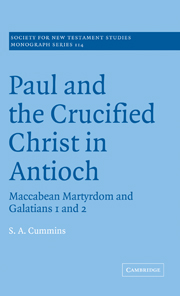Book contents
- Frontmatter
- Contents
- Preface
- List of abbreviations
- Introduction
- Part One MACCABEAN MARTYRDOM
- Part Two PAUL AND THE CRUCIFIED CHRIST IN ANTIOCH
- 3 Paul as a paradigm of conformity to Christ: the Galatian context, conceptual framework and autobiography
- 4 Jews and Christians in Antioch
- 5 Paul and the crucified Christ in Antioch: Galatians 2.11–14
- 6 Paul and the crucified Christ in Antioch: Galatians 2.15–21
- Conclusion
- Bibliography
- Index of passages
- Select index of Greek words and phrases
- Index of modern authors
- Select index of names and subjects
4 - Jews and Christians in Antioch
Published online by Cambridge University Press: 22 September 2009
- Frontmatter
- Contents
- Preface
- List of abbreviations
- Introduction
- Part One MACCABEAN MARTYRDOM
- Part Two PAUL AND THE CRUCIFIED CHRIST IN ANTIOCH
- 3 Paul as a paradigm of conformity to Christ: the Galatian context, conceptual framework and autobiography
- 4 Jews and Christians in Antioch
- 5 Paul and the crucified Christ in Antioch: Galatians 2.11–14
- 6 Paul and the crucified Christ in Antioch: Galatians 2.15–21
- Conclusion
- Bibliography
- Index of passages
- Select index of Greek words and phrases
- Index of modern authors
- Select index of names and subjects
Summary
Having established in chapters one and two Maccabean martyrdom as a frame of reference for the analysis of Galatians 1–2 as a whole, here I consider the available external evidence in providing a related but more Antioch-specific framework for the ensuing detailed discussion of the Antioch incident in Galatians 2.11–21. The primary aim is to indicate how there would have been much tension and conflict between the Jewish and Christian communities in Antioch, especially insofar as this involved competing claims as to what it meant to be the faithful people of God. Whereas the Jewish community could readily have invoked the Torah-obedient Maccabeans as their ideal in this respect, the Christians would have laid claim to the martyred and exalted Messiah Jesus as their exemplar.
In what follows I shall examine in turn two different but complementary sources and observe the portraits which emerge therefrom. First, I offer a reconstruction of the history and self-identity of the Antiochene Jewish community as (largely) suggested by Josephus. This will be followed by an outline of the emerging Antiochene Christian community according to the narrative in Acts, with particular reference to its leadership and common life. From this broad standpoint I shall then be in a position to undertake the final stage of this enterprise: a detailed consideration of Paul's account of the Antioch incident, with its radical reworking of Maccabean themes and issues in service of a thoroughly Messiah Jesus understanding of God and his people.
- Type
- Chapter
- Information
- Paul and the Crucified Christ in AntiochMaccabean Martyrdom and Galatians 1 and 2, pp. 138 - 160Publisher: Cambridge University PressPrint publication year: 2001

